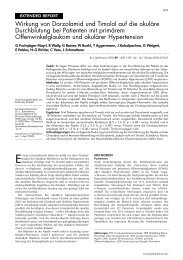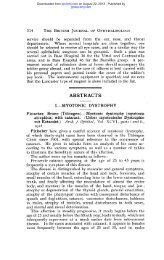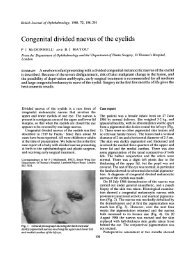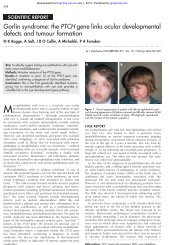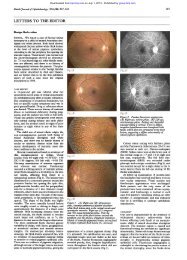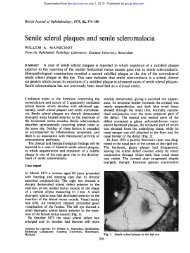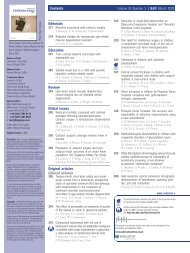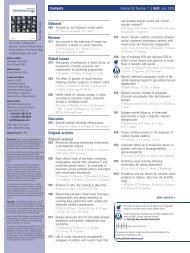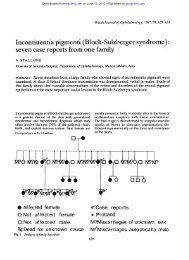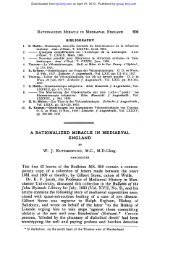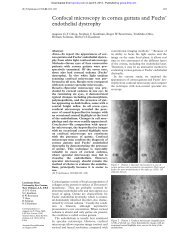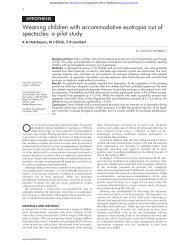Methylcellulose and lens implantation - British Journal of ...
Methylcellulose and lens implantation - British Journal of ...
Methylcellulose and lens implantation - British Journal of ...
You also want an ePaper? Increase the reach of your titles
YUMPU automatically turns print PDFs into web optimized ePapers that Google loves.
Downloaded from bjo.bmj.com on February 4, 2014 - Published by group.bmj.com<br />
262<br />
<strong>and</strong> a few cells were observed for a few days. No<br />
hypopyon occurred. (All <strong>lens</strong>es had been wetsterilised<br />
by Medical Workshop.) Only a few eyes<br />
with a more pronounced exudation were observed.<br />
This could not have been the result <strong>of</strong> the methylcellulose,<br />
because the methylcellulose was always<br />
withdrawn from one bottle for several <strong>implantation</strong>s,<br />
while the postoperative cases <strong>of</strong> iritis occurred only<br />
sporadically, never epidemically.<br />
POSTOPERATIVE STATE OF THE CORNEA<br />
Each operation was graded according to a subjective<br />
impression <strong>of</strong> quality, <strong>and</strong> later compared with the<br />
postoperative appearance <strong>of</strong> the cornea. In the cases<br />
with the highest grade (most eyes), the corneae were<br />
nearly clear at the first postoperative day, <strong>and</strong><br />
completely clear by the third day.<br />
The endothelium was observed postoperatively in<br />
about 100 cases by noncontact specular microscopy<br />
<strong>and</strong> with the help <strong>of</strong> a McIntyre grid <strong>and</strong> compared<br />
with the nonoperated eye. In most <strong>of</strong> the operated<br />
eyes there were about 2000 endothelial cells per<br />
square mm in both eyes. To us this indicated a lack <strong>of</strong><br />
any toxic effect <strong>of</strong> methylcellulose on the endothelium.<br />
Therefore as a clinical impression on the basis <strong>of</strong><br />
approximately 2,000 postoperative slit-lamp<br />
examinations on 417 eyes it can be stated that<br />
methylcellulose did not harm the endothelium. Since<br />
the mechanical advantage <strong>of</strong> this adjunct to the<br />
operation is so evident, the overall effect on the<br />
cornea must obviously be beneficial.<br />
Discussion<br />
Healon was recently considered 'the most important<br />
substance to come along in cataract surgery since<br />
alpha-chymotrypsin'. 6 This statement, however,<br />
must be qualified. What matters is not Healon but<br />
appropriate viscous material in the eye. Healon,<br />
despite its value, has its disadvantages: it is very<br />
expensive, not universally available, <strong>and</strong> it is difficult<br />
to dilute. For the last reason a relatively large amount<br />
<strong>of</strong> the material may remain in the eye <strong>and</strong> cause a<br />
dangerous rise <strong>of</strong> pressure postoperatively. 17<br />
We prefer methylcellulose 2% dissolved in BSS.<br />
Fleming et al.'8 have shown that methylcellulose<br />
inside the eye is harmless. <strong>Methylcellulose</strong> has many<br />
advantages. As an adjunct to <strong>lens</strong> <strong>implantation</strong> it is<br />
perfect. It coats the <strong>lens</strong> <strong>and</strong> deepens a shallow<br />
anterior chamber. It is universally available <strong>and</strong><br />
inexpensive. The solution is comparatively easy to<br />
prepare-at least for a moderately equipped<br />
pharmacy. This is advantageous in underdeveloped<br />
<strong>and</strong> developing countries. The solution can be<br />
resterilised, thereby further decreasing the cost<br />
Paul U. Fechner <strong>and</strong> Martin U. Fechner<br />
factor. It can be stained blue for easy recognition<br />
inside the anterior chamber. It is-<strong>and</strong> this is a very<br />
important point-easily diluted <strong>and</strong> can be largely<br />
removed from the anterior chamber without difficulty.<br />
If postoperative rises <strong>of</strong> intraocular pressure<br />
occur owing to its use, they are easily manageable <strong>and</strong><br />
not clinically significant.<br />
Because methylcellulose is a nonphysiological <strong>and</strong><br />
possibly nonmetabolic substance consisting <strong>of</strong> large<br />
polymers, it could be argued that the residue which<br />
remains in the eye at the end <strong>of</strong> the operation might<br />
clog the trabecular meshwork <strong>and</strong> cause dangerous<br />
bouts <strong>of</strong> glaucoma, as has been reported after the use<br />
<strong>of</strong> Healon"' Our results show that this is definitely<br />
not so. As can be seen from Figs. 1 <strong>and</strong> 2, the intraocular<br />
pressure at the first postoperative day was 33-1<br />
mmHg after intracapsular operation, <strong>and</strong> 30-2 mmHg<br />
after extracapsular operation (with acetazolamide).<br />
Obviously the difference between the pressures must<br />
be due to the increased tension following the<br />
enzymatic zonulolysis. But even after extracapsular<br />
operation pressure rises occur which seem in the<br />
first place to be due to the trauma <strong>of</strong> the operation<br />
<strong>and</strong> <strong>lens</strong> material remaining in the anterior chamber.<br />
It is unclear whether remnants <strong>of</strong> methylcellulose in<br />
the anterior chamber in addition increase the postoperative<br />
intraocular pressure. Whether this is so<strong>and</strong><br />
if so, to what extent-could not be clarified.<br />
What was shown, however, was the unequivocally<br />
benign behaviour <strong>of</strong> the methylcellulose inside the<br />
eye with respect to the postoperative pressure.<br />
As regards the argument that methylcellulose<br />
cannot be metabolised, one must consider the<br />
quantity under discussion. If 20% <strong>of</strong> what was<br />
injected into the eye-say 0-5 ml-stays in the<br />
anterior chamber, this amounts to only 2 mg <strong>of</strong> the<br />
dry substance <strong>of</strong> methylcellulose, a substance<br />
considered to be inert <strong>and</strong> confirmed by our<br />
experience to be so. None <strong>of</strong> the patients showed any<br />
ill effect either systemically or locally which could be<br />
related to methylcellulose.<br />
With respect to the cornea we did not prove that<br />
methylcellulose was more beneficial than Healon or<br />
air or no cushioning substance at all. But since most<br />
eyes which where examined by noncontact specular<br />
microscopy did show a very high endothelial cell<br />
count (practically equal to that <strong>of</strong> the nonoperated<br />
eyes) we feel justified in the assumption that methylcellulose<br />
is at least not toxic to the endothelium. That<br />
it is <strong>of</strong> benefit is a belief based on our experience that<br />
<strong>implantation</strong> in so many cases is much facilitated by<br />
its use.<br />
In summary, our experience <strong>of</strong> over 6 years with<br />
methylcellulose leads us to believe that this substance<br />
is most valuable in intraocular surgery whenever a<br />
cushioning substance other than air is needed in the



